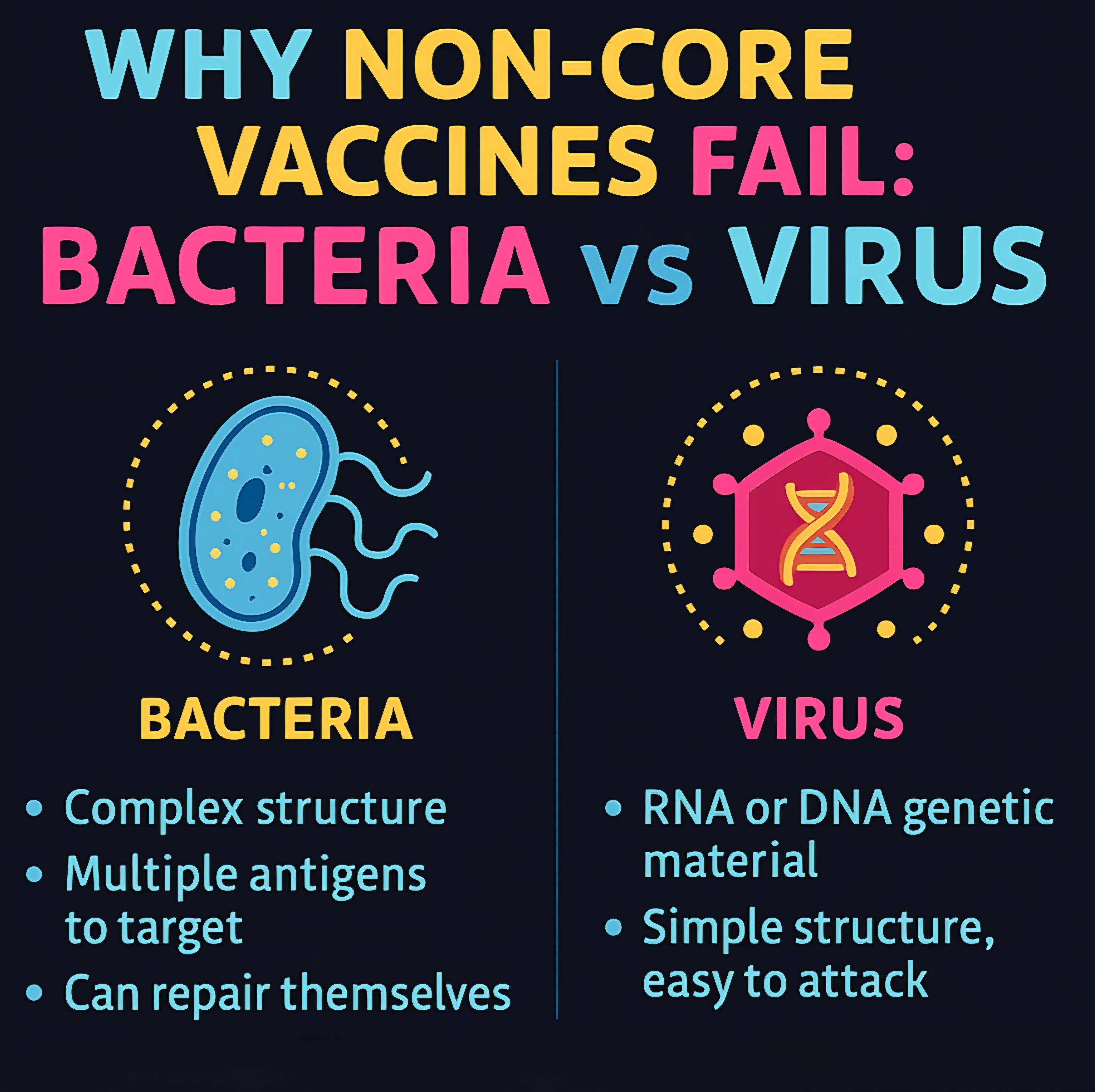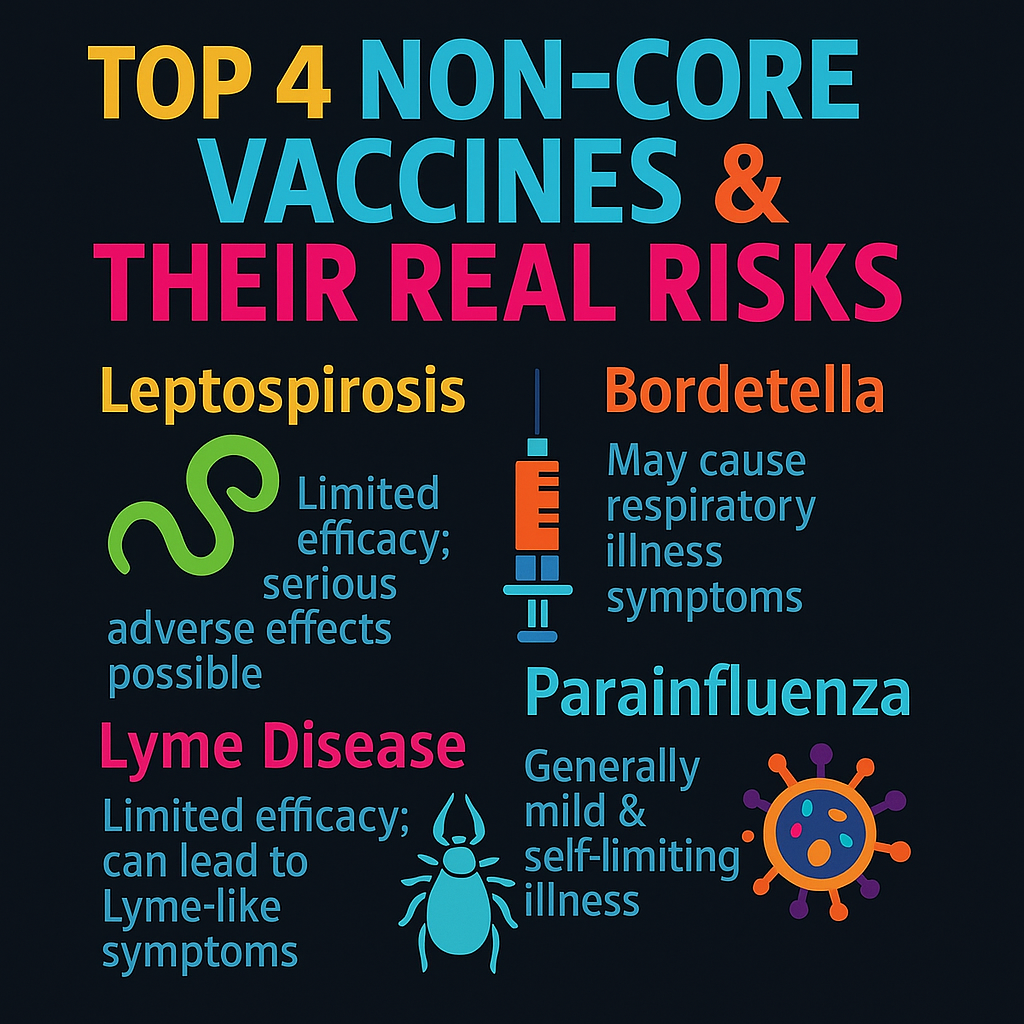1. What Are Non-Core Vaccines?
Non-core vaccines are the shots your vet might recommend in addition to the core ones—but they’re not required. These include:
- Leptospirosis
- Bordetella (Kennel Cough)
- Lyme Disease
- Parainfluenza
They’re often suggested “just in case,” especially for dogs who board, go to daycare, or spend time outdoors.
But here’s what most people don’t know: These vaccines are poorly effective, frequently harmful, and often completely unnecessary.
Let’s break down why.

2. Viral vs. Bacterial Diseases: Why These Vaccines Fail
Vaccines for viral diseases (like Parvo or Distemper) work well. Why? Because viruses are simple. Stable. Easy to target.
But bacteria are a different story.
Bacteria are:
- Structurally complex
- Capable of repairing themselves (even after being weakened in a vaccine)
- Full of multiple antigens that vary by strain
- Notoriously difficult to vaccinate against effectively
In short: You can’t expect a vaccine for a bacterial illness to behave like a vaccine for a virus.
Yet the industry pretends otherwise.
3. Why Bacterial Vaccines Can Make Your Dog Sick
When you vaccinate against a bacterial illness:
- You often inject attenuated (weakened) bacteria
- But bacteria can repair themselves once inside the body
- The immune system is caught off-guard, especially since vaccines are injected outside natural entry points (like the GI tract or respiratory lining)
That’s why dogs frequently develop symptoms of the very disease they were vaccinated for:
- Nasal discharge
- Cough
- Fever
- Lethargy
- Gastrointestinal upset
- Neurological reactions
- And in severe cases, systemic immune collapse
And almost no one connects it to the vaccine.

4. Breaking Down the Non-Core Vaccines
Leptospirosis Vaccine
- Only covers a few strains out of many
- Most dogs who get Lepto are infected with a strain not covered by the vaccine
- Reactions can be severe—especially in puppies and small breeds
- Several of our NAID puppies have experienced serious adverse events after receiving this shot
Bottom line: High risk, low reward. Most often, not worth it.
Lyme Disease Vaccine
- Lyme vaccine for humans was pulled from the market due to adverse reactions
- The same company makes the dog version—and it’s still in use
- Dogs often develop Lyme-like symptoms after being vaccinated
- Lyme is often treatable with herbs and early intervention
Bottom line: If it wasn’t safe for humans, why are we pushing it on dogs?
Bordetella (Kennel Cough) Vaccine
- Mild, self-limiting illness in healthy dogs
- Doesn’t prevent infection
- Vaccinated dogs still shed the bacteria and still get sick
- Example: One of our pup owners watched her dog get sick every single time after this vaccine—only to be treated repeatedly with antibiotics that made things worse
Bottom line: This vaccine is doing more harm than good in most cases.
Parainfluenza Vaccine
- Often included in combo shots (like DHPP) without informed consent
- Causes a cold-like respiratory illness
- Not dangerous to healthy dogs
- Natural exposure builds better immunity than any injection
Bottom line: If your dog gets it, they’ll recover—and be stronger for it.
5. Natural Immunity Is Often the Better Path
These non-core diseases are typically:
- Non-life-threatening
- Self-limiting
- Mild in healthy dogs
If your dog contracts one of these illnesses and recovers naturally, they gain:
- Stronger, long-lasting immunity
- A more balanced immune response
- No risk of vaccine-related side effects
We have to stop trying to shield our dogs from every sniffle and sneeze.
Let them build immunity the natural way—through exposure, experience, and recovery.
6. Why It Matters HOW a Vaccine Enters the Body
Most diseases enter through the respiratory or digestive tract, where the body is equipped with specialized immune tissues.
Vaccines, on the other hand, are injected:
- Into the muscle or subcutaneous tissue
- Where no immune structures exist to handle foreign pathogens
- Along with adjuvants to artificially stimulate the immune system
The result? A disrupted immune response that can lead to chronic inflammation, suppressed function, or overactivation of the immune system.
This is why even mild vaccines can cause lingering effects.
7. You’re Allowed to Say No
These vaccines are not required by law.And more importantly—they’re not needed by most dogs.
So why are they being pushed?
Because vet care, like medical care, is part of an industry. And that industry operates on a revenue-first model. And vaccines—especially non-core ones—are quick, cheap, and profitable.
But just because your vet recommends them doesn’t mean you have to say yes.
8. Final Thoughts: This Isn’t About Saying No to Everything—It’s About Saying Yes to What’s Best
We’re not here to make blanket statements. We’re here to help you think clearly, independently, and fearlessly.
If your dog needs protection—protect them. But do it with science, intention, and discernment.
The goal isn’t to say “never vaccinate.” The goal is to say “only when it’s right.”
And to stand firm in your decision—even when others don’t understand.
Knowledge is freedom.
Courage is power.
And your dog is counting on you.
🌐 Want To Learn More?
Dr. Jean Dodds Vaccine Protocols
AAHA Guidelines on Non-Core Vaccines
American Veterinary Medical Association on Vaccine Reactions

